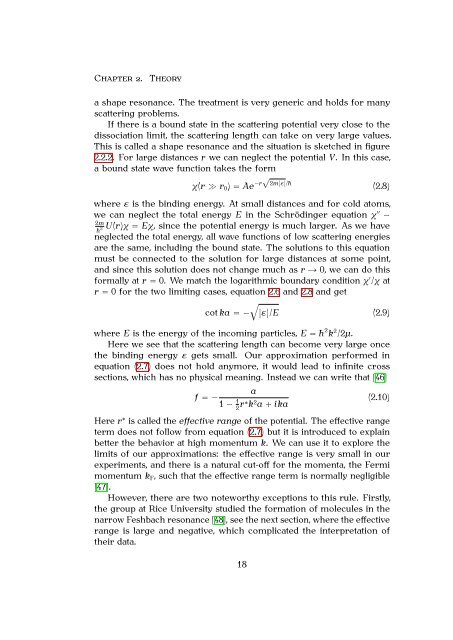Martin Teichmann Atomes de lithium-6 ultra froids dans la ... - TEL
Martin Teichmann Atomes de lithium-6 ultra froids dans la ... - TEL
Martin Teichmann Atomes de lithium-6 ultra froids dans la ... - TEL
Create successful ePaper yourself
Turn your PDF publications into a flip-book with our unique Google optimized e-Paper software.
CHAPTER 2. THEORY<br />
a shape resonance. The treatment is very generic and holds for many<br />
scattering problems.<br />
If there is a bound state in the scattering potential very close to the<br />
dissociation limit, the scattering length can take on very <strong>la</strong>rge values.<br />
This is called a shape resonance and the situation is sketched in figure<br />
2.2.2. For <strong>la</strong>rge distances r we can neglect the potential V. In this case,<br />
a bound state wave function takes the form<br />
χ(r ≫ r0) = Ae −r√ 2m|ε|/¯h<br />
(2.8)<br />
where ε is the binding energy. At small distances and for cold atoms,<br />
we can neglect the total energy E in the Schrödinger equation χ ′′ −<br />
2m<br />
¯h 2 U(r)χ = Eχ, since the potential energy is much <strong>la</strong>rger. As we have<br />
neglected the total energy, all wave functions of low scattering energies<br />
are the same, including the bound state. The solutions to this equation<br />
must be connected to the solution for <strong>la</strong>rge distances at some point,<br />
and since this solution does not change much as r � 0, we can do this<br />
formally at r = 0. We match the logarithmic boundary condition χ ′ /χ at<br />
r = 0 for the two limiting cases, equation 2.6 and 2.8 and get<br />
�<br />
cot ka = − |ε|/E (2.9)<br />
where E is the energy of the incoming particles, E = ¯h 2 k 2 /2µ.<br />
Here we see that the scattering length can become very <strong>la</strong>rge once<br />
the binding energy ε gets small. Our approximation performed in<br />
equation (2.7) does not hold anymore, it would lead to infinite cross<br />
sections, which has no physical meaning. Instead we can write that [46]<br />
a<br />
f = −<br />
1 − 1<br />
2r∗k 2a + ika<br />
(2.10)<br />
Here r ∗ is called the effective range of the potential. The effective range<br />
term does not follow from equation (2.7) but it is introduced to exp<strong>la</strong>in<br />
better the behavior at high momentum k. We can use it to explore the<br />
limits of our approximations: the effective range is very small in our<br />
experiments, and there is a natural cut-off for the momenta, the Fermi<br />
momentum kF, such that the effective range term is normally negligible<br />
[47].<br />
However, there are two noteworthy exceptions to this rule. Firstly,<br />
the group at Rice University studied the formation of molecules in the<br />
narrow Feshbach resonance [48], see the next section, where the effective<br />
range is <strong>la</strong>rge and negative, which complicated the interpretation of<br />
their data.<br />
18

















